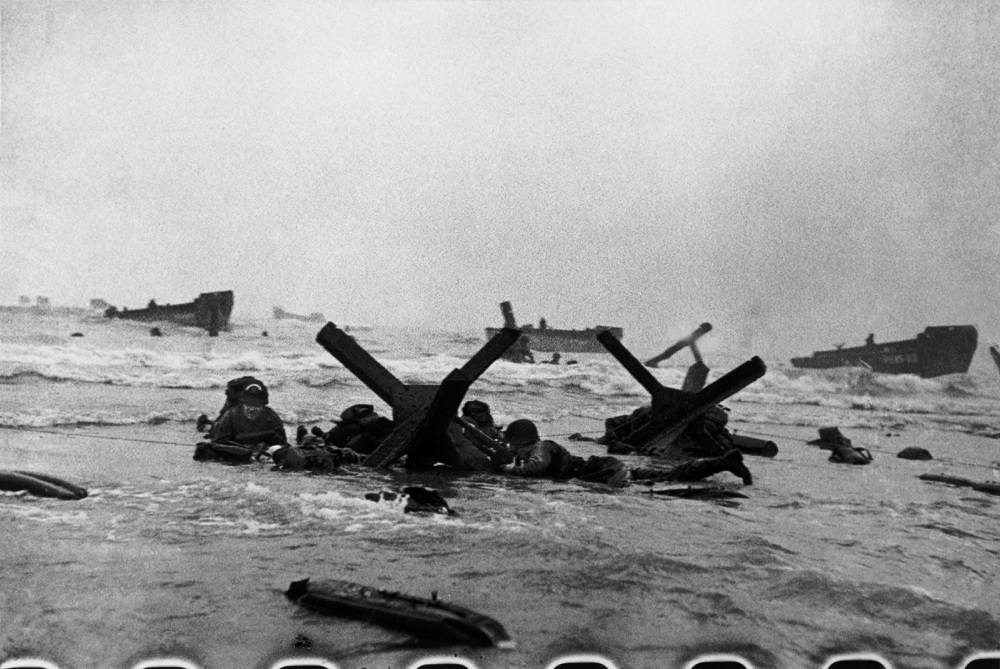
Believe it or not, this is a photo of the first wave on Omaha Beach. Can you smell the seawater?
You've seen the movie Saving Private Ryan. U.S. soldiers in the first wave of landings at Omaha Beach were massacred by German machine guns in concrete pillboxes, as well as mortar and artillery fire.
Didn't you feel that there could be some way of protecting, assisting these
troops as they came ashore?

Believe it or not, this is a photo of the first wave on Omaha Beach. Can you smell the seawater?
What about tighter, continued co-operation between naval weapons
and the assaulting troops?
What about finding a way to successfully land tanks on the shore at the same time
as the infantry?
What about closer support from the air force?
These things may be key to solving the problem of Omaha Beach. I'll leave it to others
to sort that out. I will point out three things:
Hindsight is 20/20.
There was a schedule to be kept for the complicated Operation Overlord.
Mother Nature has her own cards to play.

communication problems
How about an early morning landing by silent gliders
just behind the bluffs, followed by a
mass parachute drop, followed by landing craft, sans bombardment?
Intriguing but no.
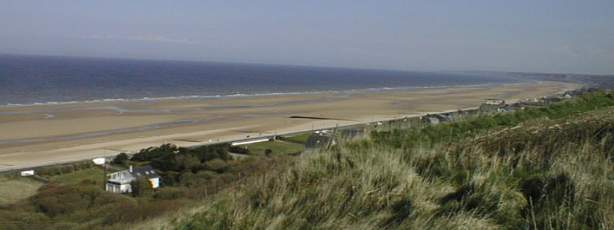
How about a "worms not waves" approach, where you land on places other than
strongpoints like Vierville draw? You could land substantial intact forces, add
tanks, then surround and clear out the strongpoints.
I don't know. On June 6 it worked out that some avoidance of
strong positions did occur.

When you watch Saving Private Ryan and see soldiers being hopelessly
cut down in a hail
of bullets the moment the ramp goes down your instinct will tell you that they need
shields. What about interlocking shields, like a Roman tortoise?
A portable frame, shields, sandbags? No.
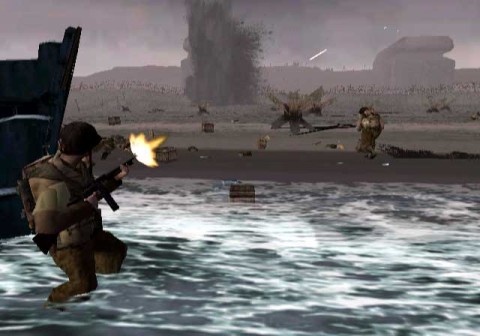
What kind of range did those Thomspons have?
What about your brave and rather obvious plan to shoot back at the enemy? Well
Do you get seasick? Have you ever seen that thing where you put your forehead on a broom on the ground and spin your whole body around it a few times, then walk somewhere? Try that, then point your broom at a distant target, or try to do anything useful. Well, before you do that, wake up very early in the morning. Just before your broom trick go into the shower, with cold water. You have boots, jacket, helmet, gas mask, miscellaneous item (1940s radio, bangalore torpedos, wire cutters), your weapon, ammunition containing lead, and grenades. Now waddle through some water. Then you can do your broom trick.
Of course you're in the Army, so you have to follow orders. Where is Captain George Stanford? What are our ord - is that Smith over there in a bloody mess? There is the matter of enemy fire, including the blasts of sound waves from shells.
Note that you may die in the next few minutes. We can't really imagine what that's like. Well, I live on the 17th floor of an apartment building (close to frequent fireworks displays by the way), and I can look out and ponder what it would be like to be tossed over the side. Imagine that - no, let's make it eighth floor or so. In the next few minutes you could get tossed over and die, or be painfully injured, or be painfully injured and die over time, or you might be fine. But try not to think about that.
Your good buddy Gerald might experience the same thing in the next few minutes too.
But try not to think about that.

What about that well-protected gun facing east?
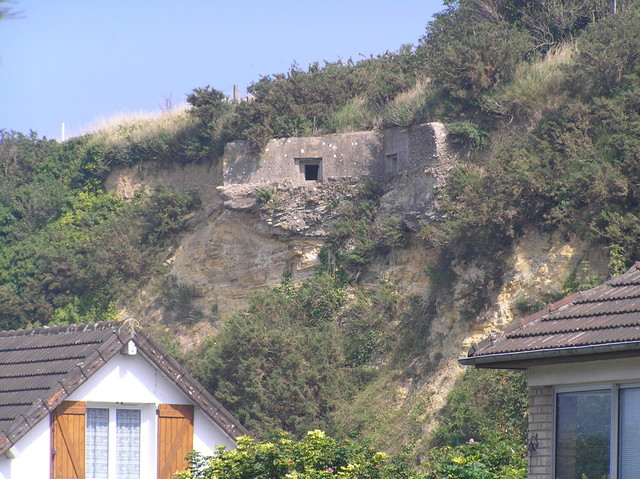
Don't be fooled by Saving Private
Ryan and the documentaries -
for the first wave at low tide (the tide moved in quickly)
there was a distance of 1000 feet
between the shore and the sea wall.
German defenders were comfortably in their concrete pillboxes
(or sandbagged pit), presenting a small target and ripping away with their
MG42 machine guns with their famously high rate of fire.

That's some cold water. Is anybody shooting?
What about bringing infantry weapon x?
They brought infantry weapon x during the first or second wave.
"Where's your B.A.R.?"
Rifle grenades?
Snipers? Nah.
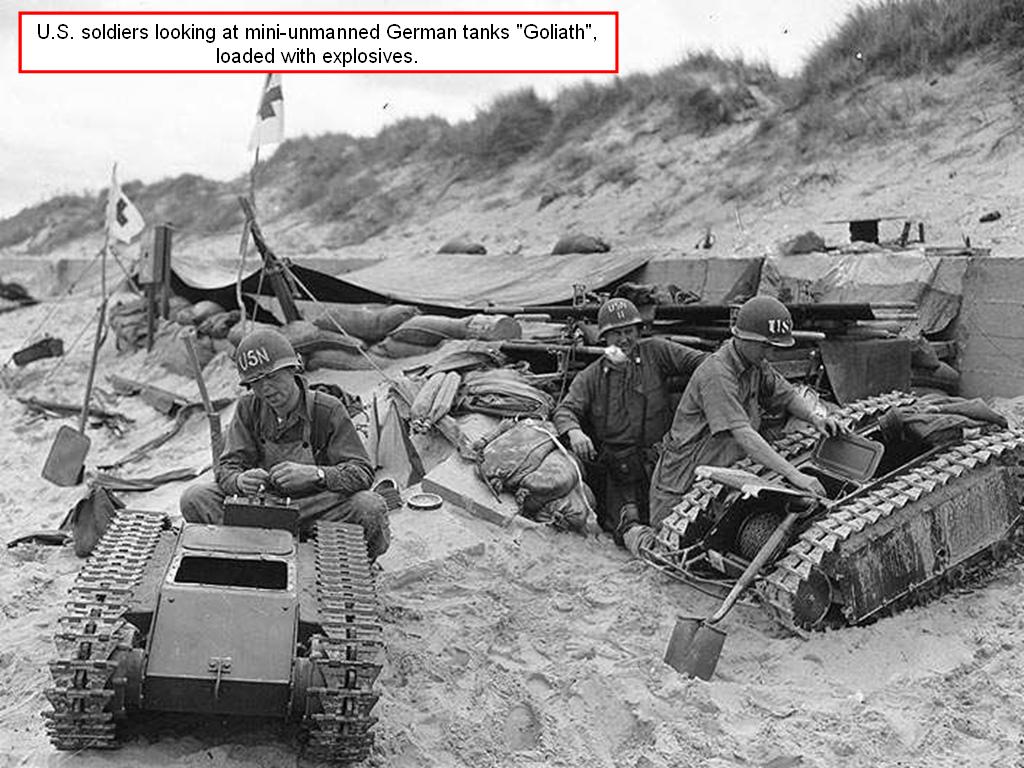
Instead of just sending bodies of frightened young men toward the enemy defenses
against their will,
what about sending unemotional mechanical devices trundling toward the enemy?
It isn't quite as crazy as it sounds. The Germans used wire-controlled Goliaths, small
treaded vehicles that were sent to enemy tanks to blow them up. They even
had them in Normandy. However, there are issues including water, how they
would be controlled (automatic?),
and Goliaths were actually vulnerable to small arms fire. What would they do anyway?
This would certainly have the German defenders scratching their helmets.
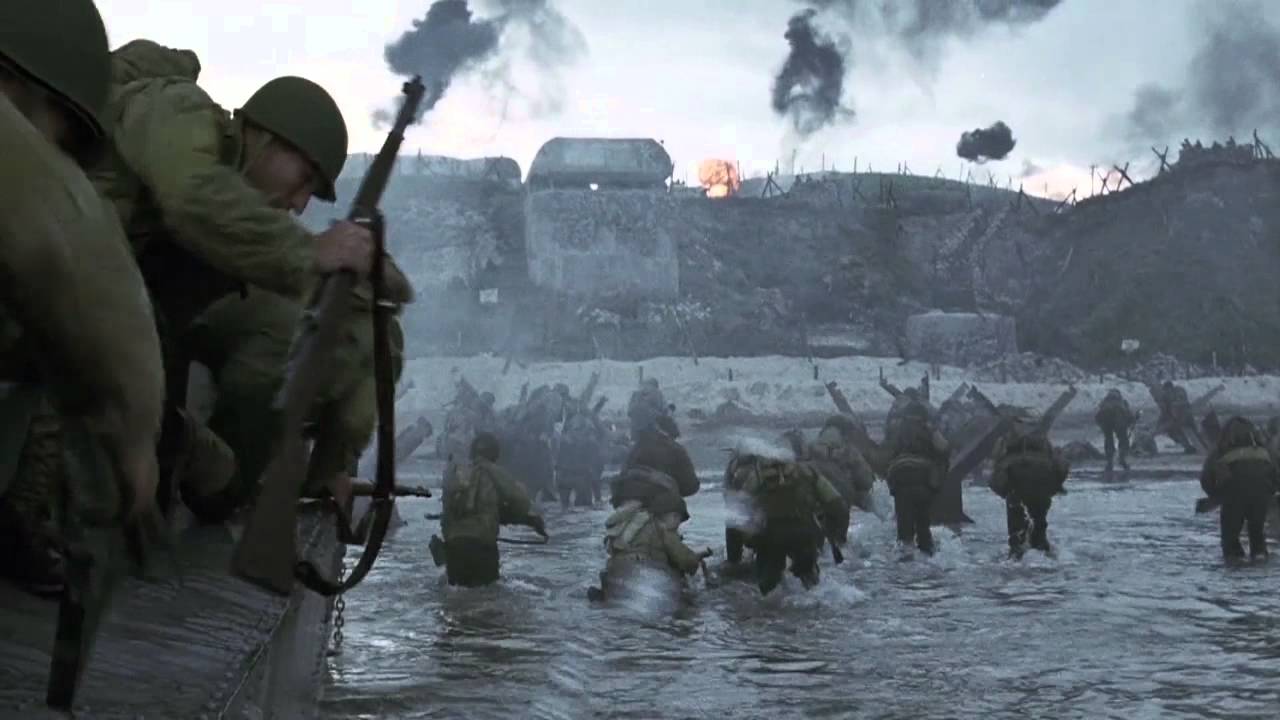
What about a bazooka, fired from the relative protection of a landing craft?
This was the idea that got me started on all this.
It makes sense when you watch Saving Private Ryan.
One man in a steady posture shooting bazookas, with an assembly line team in support instantly providing
replacement bazookas, plus some targeting tips.
In fact, how about a "multibazooka" with five bazaoka tubes together,
and some kid of trigger
mechanism? There would be a steady stream of bazooka rounds headed
toward the enemy bunkers.
No, it's effectively too distant. (Juno Beach, with its shorter
distances, might be a different matter).
How about multiple rocket launchers on the landing craft?
You can easily find footage of boats shooting
rocket barrages during D Day. What about shooting rockets direct fire,
and having these vessels go in with the landing craft?
Sherman tanks sometimes had
launchers for 60 rockets mounted on top.
So how about every third landing craft has this 60-rocket
launcher mounted above in a fixed position, for a wild and crazy direct fire
bombardment in the approach to the beach? Can you imagine
the sights, sounds and tactical implications?
But no, that's too crazy.
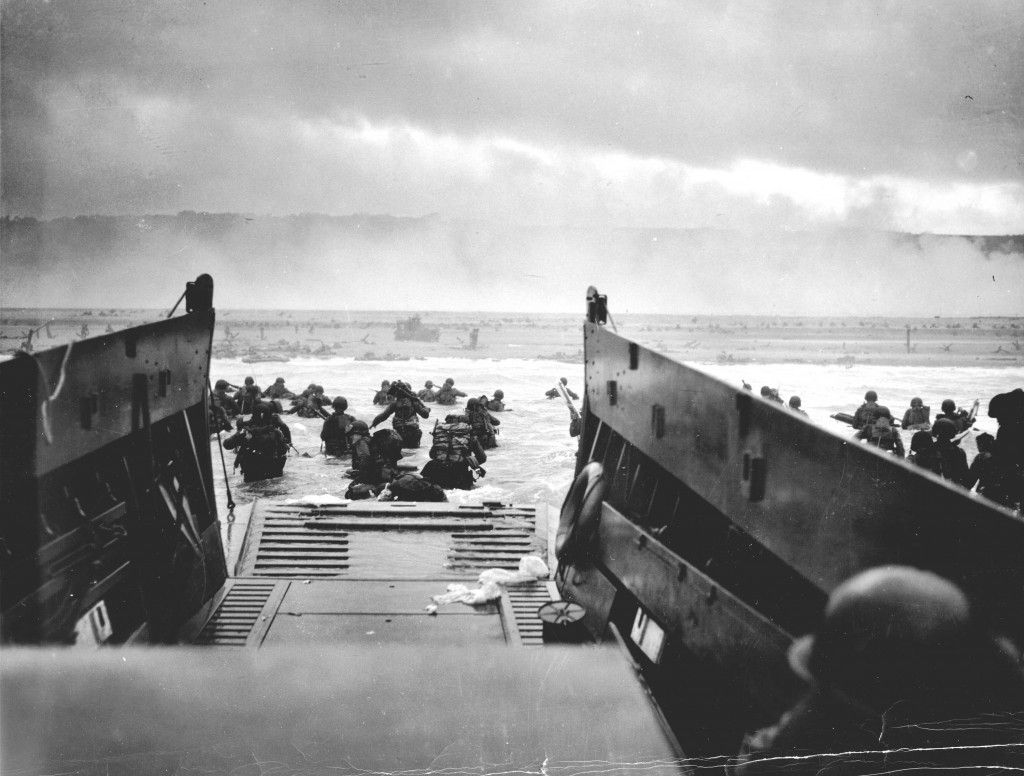
The solution is fire support boats, modified landing craft that come to shore together with the troop carrier landing craft. These are "buttoned up", with a minimal visible target, and extra protection. Watch how each stage subdues the German defenders just enough to get to the next stage.
For every 14 landing craft there are
Two rocket boats
One howitzer boat
Two machine gun / mortar boats
Nine troop carriers
Rocket boats have a rocket launcher with 60 rockets,
just like some Sherman tanks had.
They may be launched in salvos of ten rockets, direct fire.
I wouldn't want to be the coxswain.
A howitzer boat contains a 75-ml. pack howitzer. Unlike those pictures the gun has a shield, plus more walls around
the mouth of the boat so the crew is protected.
Mortars are walled off in their part of a landing craft.
The machine gun is a proper machine gun position, complete with sandbags. There is a two-man team with a water-cooled, belt-fed
machine gun.
During the approach to the beach the pack howitzers can start plinking away, in howitzer mode. Then the rocket boats can start their barrages, with the rocket launchers in fixed positions. Then the mortars would do a quick creeping barrage in the approach to the beach. How are those German arillery observers doing?
The rocket boats come just shy of hitting the beach with a last-moment barrage,
then leave.
The ramps go down on the howitzer boats, and the pack howitzers switch to direct fire.
The ramps go down on the machine gun boats, and the machine guns do their work, while
the mortars can hit their their targets on the the top of the bluffs.
The standard landing craft let loose the assault troops, they may fire off some rounds,
then leave.
After a mere four minutes landed on the beach, the howitzer and machine gun/mortar boats pull their ramps back up and leave.
Infantry would walk forward to the shingle, ideally with intact units and all their officers. The bangalore torpedo men, stripped of extra weight, would push on ahead, saving a bit of time once the assault troops reach the shingle. The infantry would provide fire support of their own, positioned half way between the shore and the sea wall - decent range for the bazookas. A couple of bazooka teams, a couple of b.a.r. teams, and I can't resist adding some riflemen. These would scoot forward to rejoin their best replica watches units at the right time. Everybody get off that beach!
Don't forget the Navy men bravely trying to remove beach obstacles. Also Ralph is back there with a shrapnel wound, so the medic is on the beach, with the tide coming in.
The second wave, arriving half an hour later with no special tricks, would reinforce the first wave, who
would have eaten into enemy defenses.
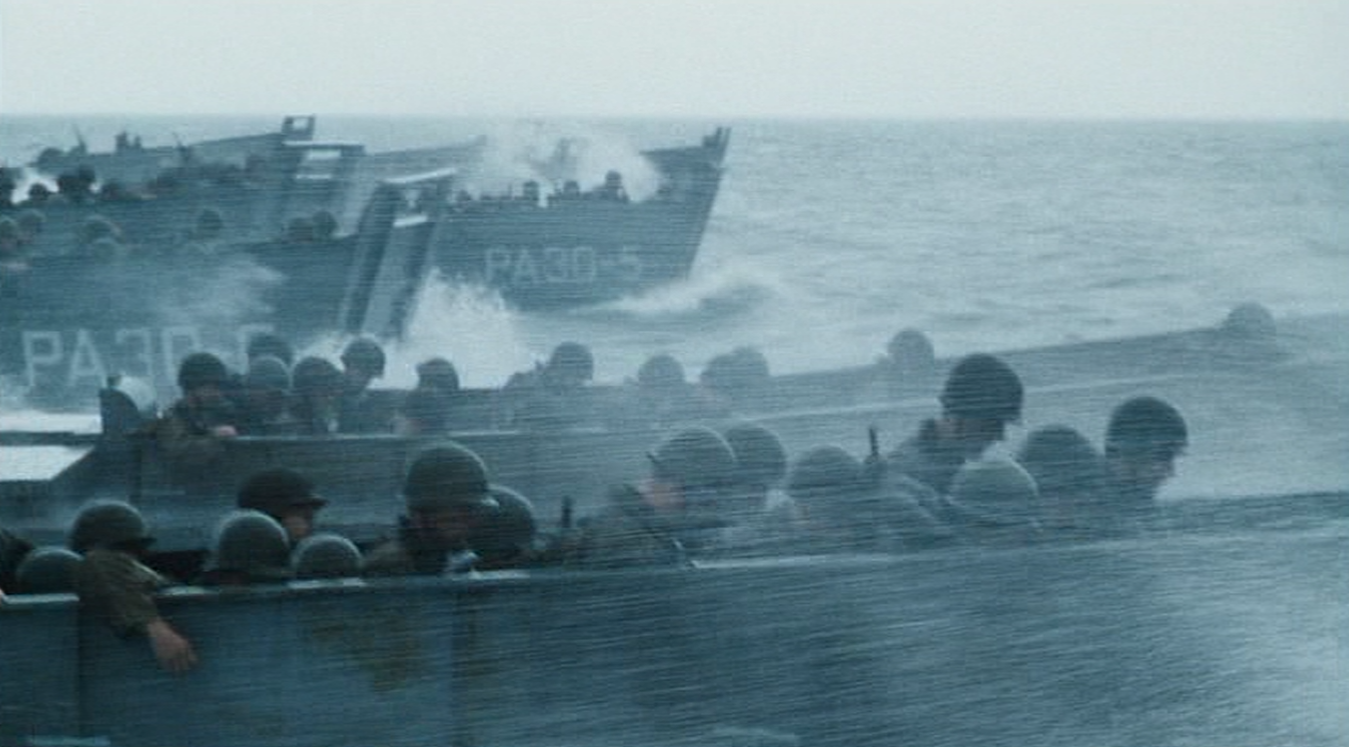

This article in The Atlantic fleshes out the disaster of the first wave at Omaha Beach.
Here is a recent BBC article that answers some questions I had about tanks.
This description of the landing includes what the troops brought with them and distances.
This
is a YouTube video showing the beach.